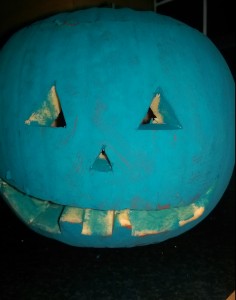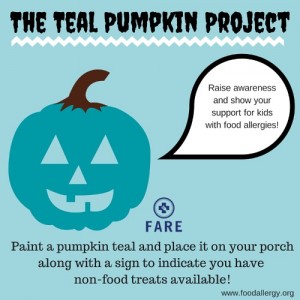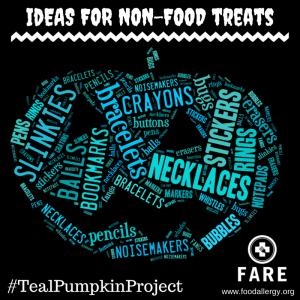The Teal Pumpkin Project


A new project has taken off in the U.S. this year in the run up to Halloween. It is getting people talking and creating allergy awareness whenever it is mentioned or discussed. The Teal Pumpkin Project was started in an allergy support group in Tennessee (FACET) and the Food Allergy Research & Education (FARE) in the US are now promoting it. The idea is very simple. If you can offer a non-food based treat as well as or instead of the usual Halloween treats, then place a teal coloured pumpkin outside your house to denote that you have allergy friendly goodies available. It is a simple matter of inclusion for children that normally might be unable to trick or treat due to the seriousness of their allergy. It has been interpreted in several ways, it is welcome news for many families with children with food allergies but for many without they may see it as being asked to change something that they’ve always done the traditional way.
So why is the teal pumpkin project important? Children like to do what their friends are doing, and the Halloween tradition of trick or treating is very widespread so of course children want to take part. Inclusion is important for children’s self confidence. This is an easy thing you can do to allow children with allergies take part in this traditional activity. Everyone wants their children not to feel excluded, and yes of course they are different if they have a food allergy but this is a simple way to include them. It’s basically a way to make Halloween more fun for those with food allergies.
As a mother of 2 children who have an allergy to milk proteins, I take extra precautions at times like Halloween when there is a lot of food based activities happening. My boys are quite young but I take them trick or treating and then inspect their loot and take out unsafe items before they are allowed to eat anything. I have explained to them not to eat as they go and I stay with them anyway. This works fine for us, my boys don’t have life-threatening allergies. In as much as they can understand at their ages, I have explained to them why they cannot have certain foods and that if they have them they will be sick. They may grumble but this is life and I’m happy for them to grow up knowing this and that they need to do certain things differently to other children to keep themselves healthy. For children who are at risk of anaphylactic shock if they come into contact with nuts, or consume dairy or soya, their parents might not have allowed them to trick or treat previously. If they now can go around the neighbourhood and a few houses have teal pumpkins outside, at least they know that they can get a safe treat at these houses. This is something simply done that can make a child’s day. Customs and traditions like this are a big part of childhood and something you always remember as an adult. Some children can now take part in this tradition who otherwise couldn’t.
One of the first things I thought of when I read about this first was the cost factor. Autumn can be an expensive time in many households with heating bills starting to come in for the winter, back to school expenses etc. I thought it might put many off if they are buying toys instead of sweets to give out at Halloween. I gave it a little more thought, and it wouldn’t cost anything extra to replace some of the sweets with a few items such as glow sticks, bubbles or a few stickers to give out. You could also have a basket with these options and one with traditional sweets and treats. Then a child can be offered a choice, and if they have an allergen can pick the non-food items.
I have seen many criticisms of the project online. I can understand the ‘why should my child miss out because your child is allergic argument’, but this project means nobody misses out. Children who are used to not being allowed to trick or treat can now take part like their friends or they can go if they normally go and they don’t have to trade their sweets for safer versions when they get home. The non allergic children have no change really except they can possibly have an option of a non food based treat instead of sweets in some houses they visit. Another criticism I’ve read is ‘why is it up to us to look after other people’s allergic kids’. I think this is a huge misunderstanding of the project. If you don’t wish to provide the non food based treats, then don’t. No parent of a severely allergic child is ever going to leave it up to anyone else to ensure that their child will consume their allergen. Any food treats given at Halloween will always need to be thoroughly checked to remove the unsafe ones. I think even if only families who have a child with a food allergy participate in this project, there will still be plenty of houses where kids can go to get safe treats.
The other aspect to all this is increased allergy awareness. The teal pumpkin project has made national news in the US and is said to have spread to many other countries too. It can be difficult to empathize with dealing with food allergies unless you have first hand experience. Allergies can kill, and this message although a dark one, is something that people need to realise. There are always warnings about the dangers of fireworks around Halloween, they can affect anyone, but the Halloween dangers for children with allergies aren’t as well known. Thumbs up for the allergy awareness the teal pumpkin project is creating.

If you are going to participate in the teal pumpkin project, you can print poster here to display on your front door.
Here are some ideas for treats.

If you are painting your pumpkin teal, you will need to mix blue, green and maybe some white paint to lighten it to get the right colour.
Will you be putting out a teal pumpkin this year? I would love to hear from you if you are.

I think it is a wonderful idea. I’ve had first hand experience with allergies and this is such a welcomed idea. We will be taking part and looking forward to painting our pumpkin tomorrow. I got stickers, bubbles, little packs of crayons to give as an alternative.
You’re all set so! I’m going to be doing pumpkin tomorrow too, let me know how yours turns out!